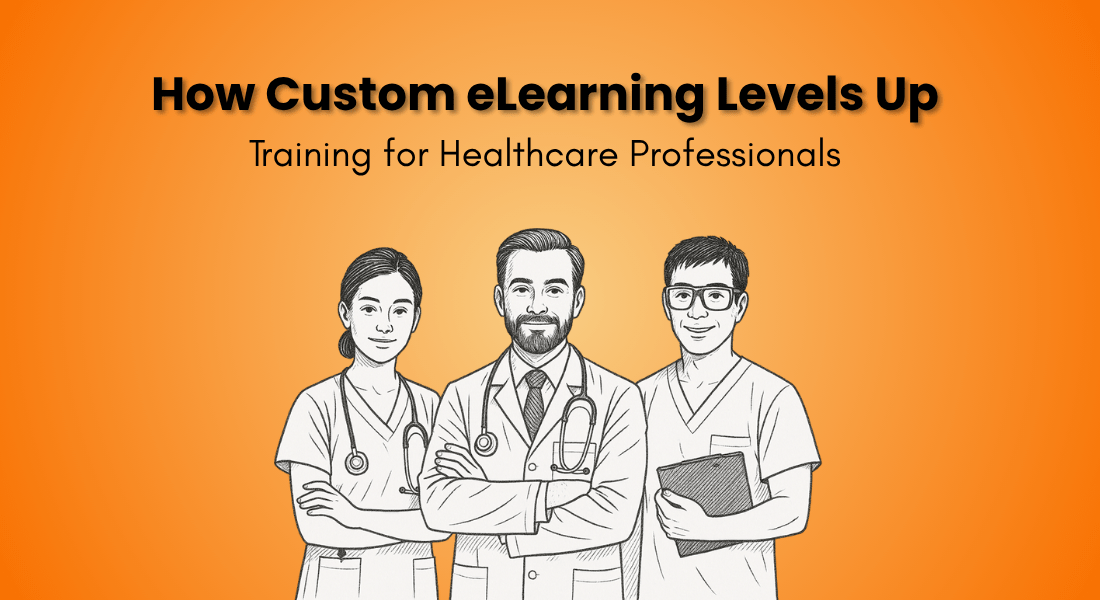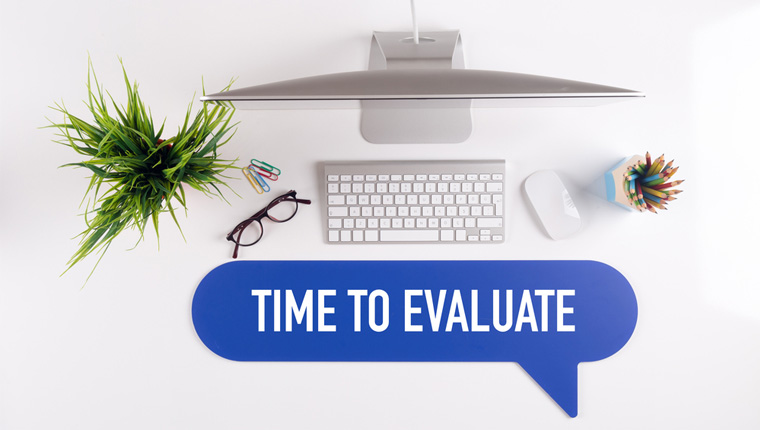Designing Custom eLearning That Fits the Demands of Healthcare Training

With the rapid advancements in treatments, technologies, and clinical protocols, healthcare teams require training that is efficient, evidence-based, and directly applicable to their daily practice. Traditional training methods, while foundational, often lack the adaptability and time efficiency needed to address the complexities of modern healthcare.
Custom eLearning for healthcare professionals represents a transformative solution. By designing content tailored to the specific challenges and demands of the healthcare environment it enables faster knowledge acquisition, improved retention, and seamless application in clinical settings.
In a profession where precision and informed decision-making are critical, customized, engaging healthcare training programs provide a meaningful opportunity for medical professionals to enhance their skills and provide better care.

Table Of Content
- What are the Unique Needs of Healthcare Training?
- What are the Top Strategies to Design Custom eLearning for Healthcare Training?
- How Custom eLearning is a Win for Healthcare Training
What are the Unique Needs of Healthcare Training?
Bridging Diverse Skill Levels
In the healthcare industry, you'll find a mix of experience levels. You might have a brand-new nurse starting their first shift alongside a surgeon with decades of expertise. How do you design training that works for both ends of the spectrum? This is where healthcare training gets tricky. A one-size-fits-all approach simply won’t cut it. Entry-level staff need foundational learning, while specialists require advanced, role-specific updates. For example, a front-desk administrator needs to understand patient data systems, but they don’t need the in-depth knowledge that a lab tech does. Good training programs recognize these differences and adapt, ensuring everyone grows in their role without feeling left behind or overwhelmed.
Tackling Complex Content Challenges
Healthcare isn’t like most industries—it’s a world of its own. Every day, professionals deal with life-saving decisions, cutting-edge technology, and constantly evolving medical practices. For example, a hospital technician is navigating the latest diagnostic software. The content they need to master isn’t just technical, it’s critical. Training in this field must be designed with pinpoint accuracy to ensure professionals not only understand but can confidently apply their knowledge in high-pressure, real-life situations. Video-based learning can be an invaluable tool in addressing these challenges. By using engaging visuals and step-by-step demonstrations, video content simplifies complex concepts and delivers information in a clear, digestible way, empowering technicians to absorb and apply their training effectively.
Discover how video-based learning is transforming the healthcare sector by improving training, enhancing patient care, and boosting knowledge retention.
In addition to addressing these challenges, Gartner emphasizes the importance of strategic planning and innovation in healthcare. By anticipating future risks and opportunities, organizations can stay ahead in an industry where precision and adaptability are key to success. Thoughtful, well-designed training plays a critical role in preparing professionals for these evolving demands while ensuring the highest quality of care.
Navigating Global Workforce Dynamics
Healthcare is a global profession. Think about it, there are nurses in remote villages, surgeons in bustling cities, and telehealth professionals connecting with patients from halfway across the world. Each of these professionals brings their own cultural experiences, perspectives, and expertise to the table. A course that works in New York might not resonate in Mumbai or Nairobi. That’s where custom eLearning solutions come into play. They need to be culturally sensitive, accessible across time zones, and tailored to the specific challenges faced in different regions. For instance, training on tropical disease management will be critical in one part of the world, while another region may need a focus on managing aging populations. Real-world relevance matters here more than ever.
Managing Tight Deadlines
Time is a luxury in healthcare. A new disease outbreak, a medical device recall, or updated clinical guidelines can come out of nowhere, leaving professionals with little time to adjust. Training needs to reflect this reality. Imagine a clinic receptionist learning how to use new scheduling software to improve patient appointments. They can’t spend hours in a classroom or scrolling through long PDFs, they need quick, digestible training that fits into their demanding schedules. Effective solutions prioritize efficiency, offering microlearning lessons that professionals can learn and apply on the fly.
For example, instead of overwhelming nurses with a full training on infection control, microlearning solutions can focus on specific topics like proper use of personal protective equipment (PPE), recognizing early signs of infection, or updated sterilization protocols, each in under 5 minutes. This approach is particularly effective for busy professionals who can access these lessons during shift breaks or between patient rounds. Hospitals and clinics often use microlearning to ensure compliance training, like hand hygiene protocols, is regularly reinforced without disrupting the workflow.
What are the Top Strategies to Design Custom eLearning for Healthcare Training?
Designing Custom eLearning for Healthcare Training? Here’s How to Nail It!
Here's a list of strategies you shouldn't miss:
- Simulations for Realistic Practice
- Gamification for Enhanced Engagement in Healthcare Training
- Scenario-Based Learning for Decision Making
- Case Study Approach for Problem-Solving
Simulations
Realistic simulations are transforming the way healthcare professionals train and prepare for real-world scenarios. By replicating complex medical situations in a controlled environment, these tools offer a safe and practical space for learners to practice and refine their skills without risking patient safety.
Why Simulations Matter
- Hands-On Experience: Simulations allow healthcare workers to engage in lifelike scenarios, such as performing emergency procedures or managing critical care situations, helping them gain confidence in their abilities.
- Improved Decision-Making: Practicing in a simulated setting enables professionals to enhance their critical thinking and make faster, more accurate decisions under pressure.
- Team Collaboration: Many simulations are designed for group practice, fostering better communication and coordination among medical teams, which is essential in high-stakes environments like emergency rooms or operating theaters.

Instructional Design Strategies to Design Engaging eLearning Courses
Design Learner-Centric eLearning
- Importance of ID Strategies in eLearning
- Parameters to Select the Right ID Strategy
- ID Strategies for Effective Results
- Case Studies
Real-World Relevance
For example, a hospital might use a simulation to train staff on responding to a cardiac arrest. During the exercise, participants can practice CPR, administer medications, and use defibrillators, all while learning to stay calm and work as a team.
By bridging the gap between theoretical knowledge and hands-on practice, simulations are shaping a more prepared and capable healthcare workforce.
Gamification
Healthcare training, while essential, can often feel repetitive and unengaging. Gamification offers a dynamic solution by applying game mechanics to training scenarios, transforming learning into an interactive and immersive experience. This approach not only boosts engagement but also improves knowledge retention and skill mastery, which are critical in high-pressure environments like hospitals.

For example, "code blue" drills are being reimagined as competitive team-based challenges. Participants earn points for administering medications or following emergency protocols under time pressure. This method simulates real-world urgency while fostering teamwork and a sense of achievement.
The benefits of gamification extend beyond engagement. It builds confidence, reduces stress, and prepares healthcare workers for high-stakes situations.
Scenario-based Learning
Quick and accurate decision-making is essential in healthcare, and scenario-based learning helps professionals practice this skill in a controlled environment.
Examples include:
- Pharmacists work through scenarios to identify drug interactions or prioritize prescriptions during a medication shortage.
By mimicking the pressure and complexity of real-life situations, scenario-based learning prepares healthcare workers for the challenges they’ll face on the job.
Case Studies
Healthcare professionals often learn best through real-life examples, and case studies provide an excellent way to bridge theory and practice. For instance, a case study module could walk doctors through diagnosing an ailment, step by step, based on actual patient data. By analyzing test results, patient history, and symptoms, learners are encouraged to think critically and apply their medical knowledge in a practical way. For nursing teams, case studies on infection control in post-surgical patients can highlight common pitfalls and best practices, ensuring better care outcomes.
How Custom eLearning is a Win for Healthcare Training?
Tackling Health Inequity: A Step-by-Step Approach
The Challenge: A major non-profit health organization faced the daunting task of increasing medical professionals' awareness of health inequities within targeted Baltimore communities. The challenge was not only to educate but also to change the approach of clinicians when dealing with patients from these communities, who are disproportionately affected by cardiovascular diseases.
The Solution: CommLab India stepped up with a custom eLearning course designed using the authoring tool, Articulate Storyline, to challenge medical practitioners through immersive scenarios and case studies. This involved interactive modules where medical practitioners observed a scenario involving an elderly African American female patient. Through the storyline, practitioners were encouraged to reflect on how they would respond in similar real-world cases, thereby fostering a deeper understanding of health inequities.
The Result: The outcome was a significant increase in clinicians' awareness regarding health inequities and a positive shift in their approach to patient care in the community.
Read the full case study to get detailed insights.
Wrapping Up!
Custom eLearning is the key to addressing the unique challenges of training for medical teams, ensuring learners are equipped with the skills and knowledge they need to excel in real-world scenarios. By leveraging strategies like immersive simulations, case studies, and interactive scenarios, organizations can create engaging and impactful learning experiences that drive better outcomes and retention.
Want to dive deeper? Download our eBook to explore the critical parameters for selecting the right instructional design strategy and discover how tailored approaches can transform your eLearning programs into powerful tools for active engagement and practical application.







